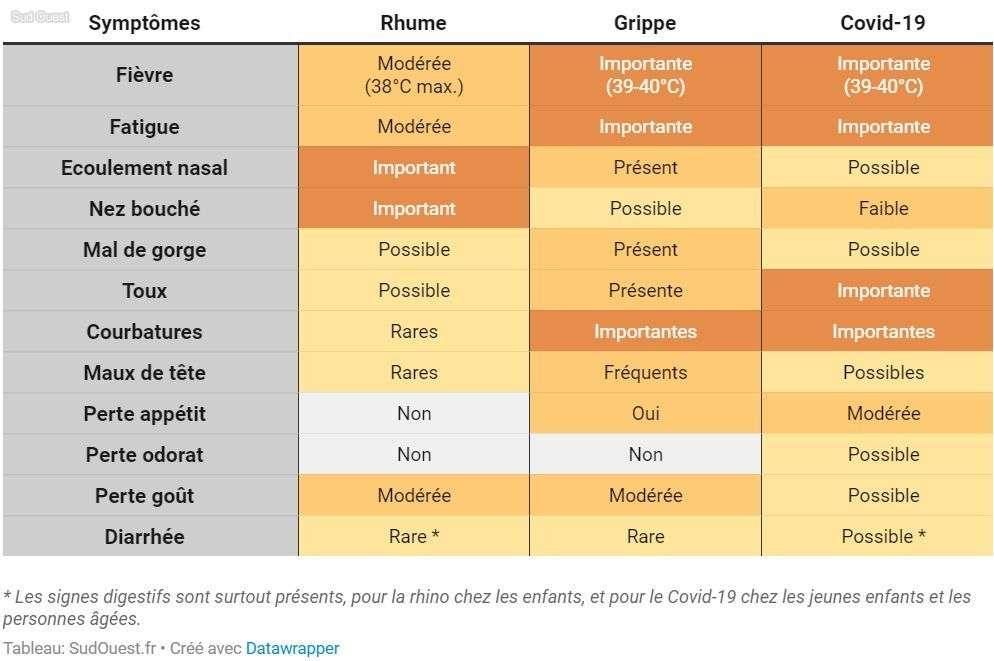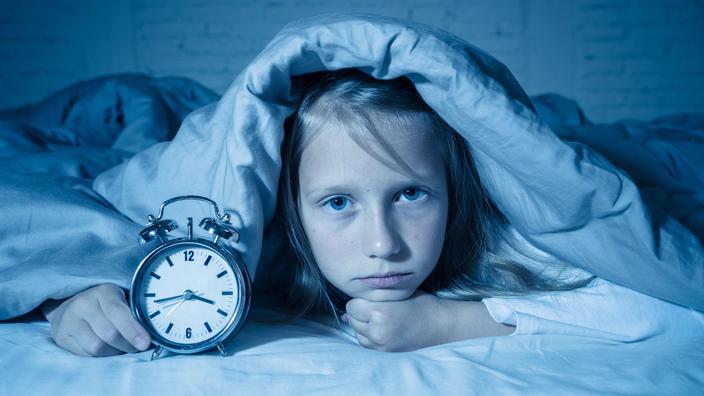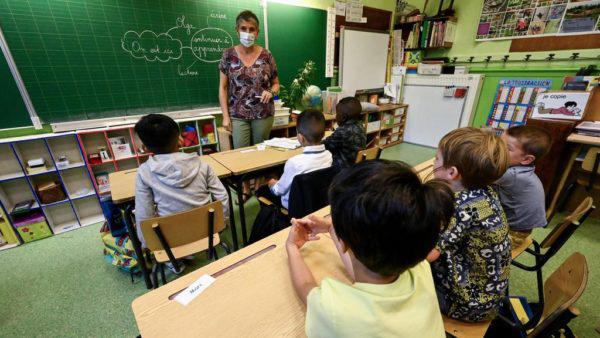
Joys of the sanitary winter: Covid, colds and flu run parallel. However, the symptoms of these three diseases often overlap. So how to make the distinction? As much to specify it from the outset, it is actually very difficult, if not impossible, to determine simply from the symptoms whether it is a cold, the flu or covid. However, some signs are more worrying than others. Point.
Read also: Contaminations continue to decline: here is the situation in your municipality
Colds, actually nasopharyngitis, are very common from the beginning of autumn, when temperatures begin to drop. And his first symptoms (runny nose, sore throat, cough, etc.) now resemble those of Covid. Which is, ultimately, nothing surprising since these are typical symptoms of infections in the ENT sphere and since covid and the viruses responsible for nasopharyngitis (there are around a hundred of them) both pass through the nose before descending to the bronchi.
Nevertheless, here are three symptoms that are only found in covid (with very rare exceptions):
On the other hand, a simple sore throat can simply be synonymous with angina or pharyngitis.
According to a World Health Organization survey of 55,924 patients in China, the most common symptoms for covid are fever (88%) and dry cough (68%), followed by fatigue (38%), expectoration of mucus (33%) and shortness of breath (19%). About 1 in 7 patients complain of sore throat, headache and muscle aches; 1 in 20 patients suffer from nausea or nasal congestion. Diarrhea (4%) and coughing up blood (1%) are even rarer.
The mild form is the most common
Diagnosis is now made even more difficult by the fact that, thanks to the vaccination campaign, the most common form of Covid is its mild form . Infected people experience few or no symptoms. Most have only a dry cough and a mild fever and sometimes watery eyes.
Incubation period and duration different for colds and covid
Incubation is 2-3 days for nasopharyngitis versus 5-8 days for covid. In theory, the immune system overcomes nasopharyngitis in a week, while for covid it can be longer, even much longer. On the other hand, as for the covid, there are no drugs against the very many viruses responsible for the common cold. So we can only relieve the symptoms.
Read also: More than 70% of patients suffering from long Covid have increased sensitivity of the nervous system
The coronavirus seems to be constantly evolving. The appearance of the Delta variant also reported different symptoms compared to those classically listed. The Omicron variant should be no exception. There seems to be a difference between the symptoms reported by vaccinated and unvaccinated people. According to a large-scale study, for unvaccinated people, the five most common symptoms are headache, sore throat, runny nose, fever and a persistent cough. These correspond to the Delta variant, now the majority in Europe. For those vaccinated, the study distinguished between symptoms after the injection of one dose and two doses.

Read also:Covid: once vaccinated, the symptoms of the disease are no longer the same
In those who have received a dose of the vaccine, the most common symptoms are headache, runny nose, sore throat, sneezing and persistent cough. “Not only is the order different, but fever is no longer in the top five and has been replaced by a new symptom: sneezing,” notes De Morgen, who analyzes the search results. Those who have been fully vaccinated (two doses, or one dose for Johnson & Johnson) report headaches, runny nose, sneezing, sore throat and loss of smell as the most common symptoms. "This time, not only the fever, but also the persistent cough has disappeared from the list. Loss of smell - a symptom of the original strain of coronavirus - is making a reappearance. Sneezing is a new symptom here too", summarizes De Morgen. "If you have been vaccinated and you suddenly start sneezing a lot for no apparent reason, it is best to do a Corona test", recommend the researchers. “Sneezing is one of the main vectors for the spread of the virus”, recalls the study.
And for children?
Even more than in adults, in children the main symptoms of covid can be reminiscent of the flu, bronchiolitis, gastroenteritis or even a cold. While the appearance of the more contagious Delta variant has triggered more symptoms in young people, the majority are still asymptomatic. In general, the symptoms of children therefore often remain very discreet and not very severe. The cough and difficulty breathing caused by covid are, for example, not easy to distinguish from those caused by bronchiolitis.
A test is only recommended for children if there are symptoms (fever, difficulty breathing, cough, digestive problems) and/or if there has been contact with a proven case.
On the other hand, it is advisable to monitor coughs and runny noses in young children, as this can also be bronchiolitis. Each year, 30% of children under two are affected by this disease, which is a viral respiratory infection that affects the bronchioles, located at the end of the bronchi. It is manifested by rapid, wheezing breathing. This disease is usually mild, but in some cases may require hospitalization, especially in very young children.
Sanitary winter joys: Covid, colds and flu run parallel. However, the symptoms of these three diseases often overlap. So how to make the distinction? As much to specify it from the outset, it is actually very difficult, if not impossible, to determine simply from the symptoms whether it is a cold, the flu or covid. However, some signs are more worrying than others. The point. The common cold, actually nasopharyngitis, is very common from the beginning of autumn, when temperatures begin to drop. And his first symptoms (runny nose, sore throat, cough, etc.) now resemble those of Covid. Which is, ultimately, nothing surprising since these are typical symptoms of infections in the ENT sphere and since covid and the viruses responsible for nasopharyngitis (there are around a hundred of them) both pass through the nose before descending to the bronchi. However, here are three symptoms that are only found in covid (with very rare exceptions): On the other hand, a simple sore throat can simply be synonymous with angina or pharyngitis. Diagnosis is now made even more difficult by the fact that, thanks to the vaccination campaign, the most common form of Covid is its mild form. Infected people experience few or no symptoms. Most have only a dry cough and a mild fever and sometimes watery eyes. The coronavirus seems to be constantly evolving. The appearance of the Delta variant also reported different symptoms compared to those classically listed. The Omicron variant should be no exception. There seems to be a difference between the symptoms reported by vaccinated and unvaccinated people. According to a large-scale study, for unvaccinated people, the five most common symptoms are headache, sore throat, runny nose, fever and a persistent cough. These correspond to the Delta variant, now the majority in Europe. For those vaccinated, the study distinguished between symptoms after the injection of one dose and two doses. In those who have received a dose of the vaccine, the most common symptoms are headache, runny nose, sore throat, sneezing and persistent cough. “Not only is the order different, but fever is no longer in the top five and has been replaced by a new symptom: sneezing,” notes De Morgen, who analyzes the search results. Those who have been fully vaccinated (two doses, or one dose for Johnson & Johnson) report headaches, runny nose, sneezing, sore throat and loss of smell as the most common symptoms. "This time, not only the fever, but also the persistent cough has disappeared from the list. Loss of smell - a symptom of the original strain of coronavirus - is making a reappearance. Sneezing is a new symptom here too", summarizes De Morgen. "If you have been vaccinated and you suddenly start sneezing a lot for no apparent reason, it is best to do a Corona test", recommend the researchers. "Sneezing is one of the main vectors for the spread of the virus", recalls the study. Even more than in adults, in children the main symptoms of covid can be reminiscent of flu, bronchiolitis, gastroenteritis or even a cold. While the appearance of the more contagious Delta variant has triggered more symptoms in young people, the majority are still asymptomatic. In general, the symptoms of children therefore often remain very discreet and not very severe. The cough and difficulty breathing caused by covid are, for example, not easy to distinguish from those caused by bronchiolitis. A test is only recommended for children if there are symptoms (fever, difficulty breathing, cough, digestive problems) and/or if there has been contact with a proven case. cough and runny nose in young children, as this can also be bronchiolitis. Each year, 30% of children under two are affected by this disease, which is a viral respiratory infection that affects the bronchioles, located at the end of the bronchi. It is manifested by rapid, wheezing breathing. This disease is usually mild, but in some cases may require hospitalization, especially in very young children.






